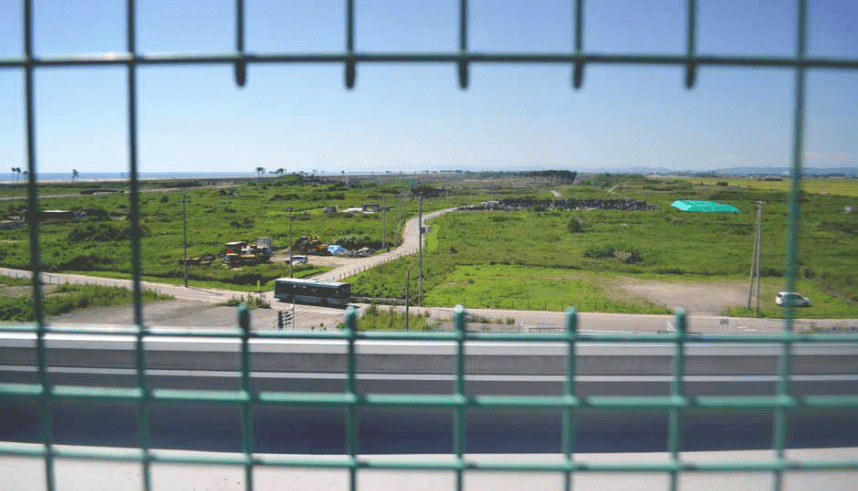The Arahama Elementary School is the only standing building of the town of Arahama that existed prior to 11 March 2011. Looking out from the top, the Sendai Plain stretches out as far as the eye can see. A sea wall appears to be in the process of construction in the distance. Cranes loom over nascent settlements and developments as part of the ongoing reconciliation. The scene heralds disbelief in knowing that before 11 March 2011, the entire area was the lively township of Arahama.
Imagine: you, a primary school child, seeing a black mass of water completely inundating the horizon all around. The world smothered by a blackened chaos of mangled cars, shredded pine trees and everything you’ve known and owned. Your house becomes consumed by the current and with it, the uncertain futures of your beloved family members and all that you love is swept into doubt. All you can do is scream.
Skeletal pine trees dot the coastline, where previously there was a lush park situated just on the beach at the edge of the town. All that remains of the Arahama township are, somewhat poetically, the remains of the cemetery.
The 2011 Tohoku Earthquake and Tsunami, termed ‘3-11’, was a one-in-one-thousand-year event that measured a magnitude of 9.0 off the east coast of Japan. The devastation witnessed was akin to an event in 869 AD, and the scale of catastrophe similar to an earthquake and tsunami in 1896. Research following 3-11 has produced evidence of this in the geological record – research which will be used to inform future disaster management policy.
Crucially, this research generates longevity to the risks posed by geological hazards: that future generations must not forget the importance of research which prepares for the worst.
Outside of a curiosity for the world around, research in science is often hard to place in a context which remains seemingly relevant to our everyday lives. It’s also something which remains at the forefront of studying science, where the question of what will be tested dominates classroom discussion. And without a broader contextual basis for a science degree and where mere grades remain as the imperative, it’s easy to become disillusioned with the study of science.
Looking and hearing about the role of science in preventing human tragedies is often relegated to the pursuit of being a medical practitioner. But the human element of scientific research persists, whatever the field of research.
3-11 galvanised research which investigates the causes and effects of the forces natural world which affect human society. Few would one know that the calcium content of the waters surrounding the Fukushima Dai-ichi Nuclear Power Plant would cause radioactive caesium to remain bound to the clay in the water which allowed most of the radioactive particles to be filtered out. Further yet, research allows us to distinguish the relatively minor consequences of the nuclear meltdown of the Fukushima Dai-ichi Nuclear Power Plant from the catastrophe of Chernobyl.
This research allows for future methods of the removal of radioactive particles to be developed, ensuring the lives of millions in the future.
In another example and as alluded above, research into sediments deposited in the Sendai Plain has revealed consistent tsunamis adjacent to the ocean as occurring on a one-in-one-hundred-year basis, and catastrophic tsunamis like 3-11 as occurring on a similarly periodic basis. Remaining true to the steadfastness of the human vision, the Arahama area – along with other areas affected by the 3-11 tsunami – has accordingly been designated as only being occupied by businesses which rely on proximity to the ocean: no residential development is permitted.
All this research is inextricably tied with the raw, human element that spurred this research in the first place. Social efforts to never forget the dangers of tsunamis and earthquakes, along with the investigative progress of research, allows for the development of policy which ameliorates the catastrophes of the future.
This is just one context in which research is being used to understand the forces of the world around. Other examples include the improvement of building codes; the effective design of infrastructure; the mechanisms of chemical or disease transport or of disease.
Research has the potential to save the lives of millions. It is essential that scientific research never loses sight of its capacity to prevent scenes like that at the Arahama Elementary School: that research must never lose the human imperative behind science.
The author travelled to the Arahama Elementary School and the surrounding Sendai region affected by the 2011 Tohoku Earthquake and Tsunami as part of the ‘Understanding Geological Hazards’ New Colombo Plan field program with the Research School of Earth Sciences, in conjunction with the University of Tokyo.
We acknowledge the Ngunnawal and Ngambri people, who are the Traditional Custodians of the land on which Woroni, Woroni Radio and Woroni TV are created, edited, published, printed and distributed. We pay our respects to Elders past and present. We acknowledge that the name Woroni was taken from the Wadi Wadi Nation without permission, and we are striving to do better for future reconciliation.
